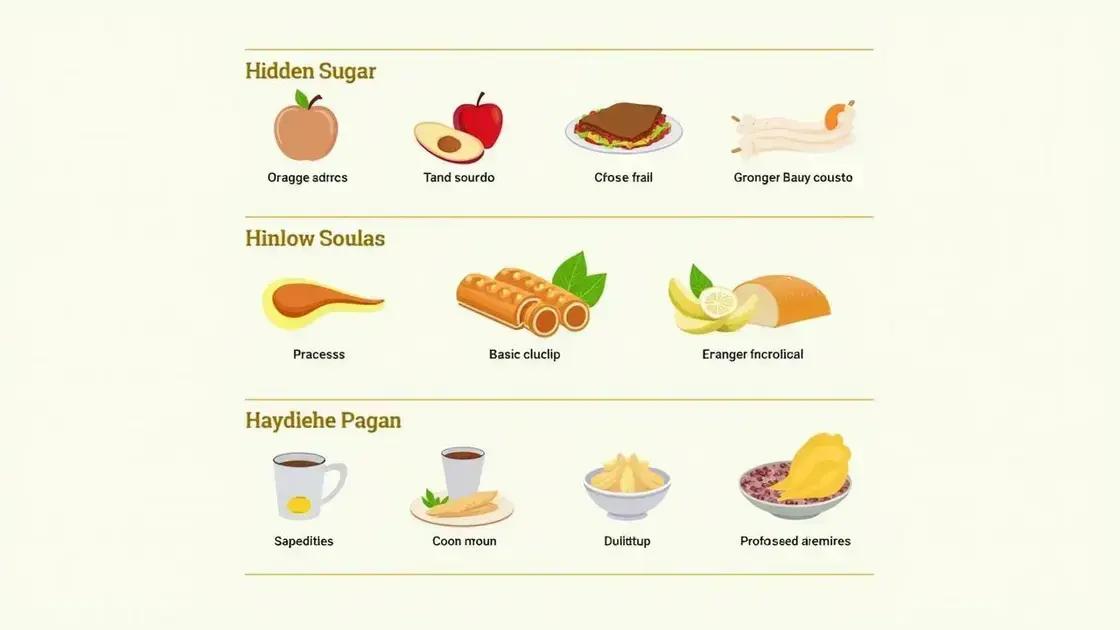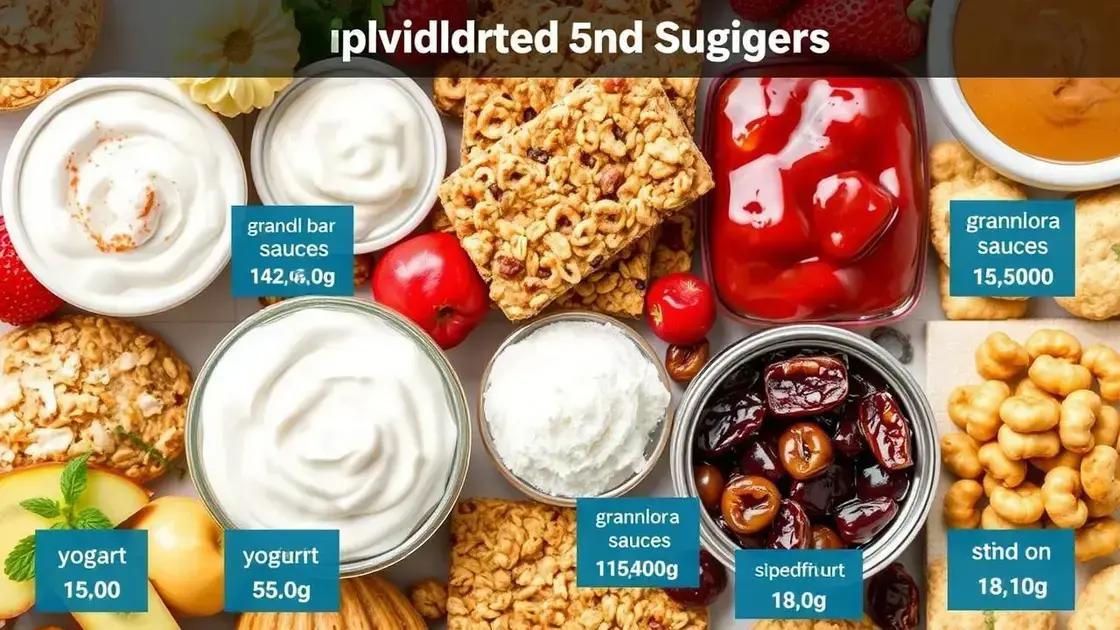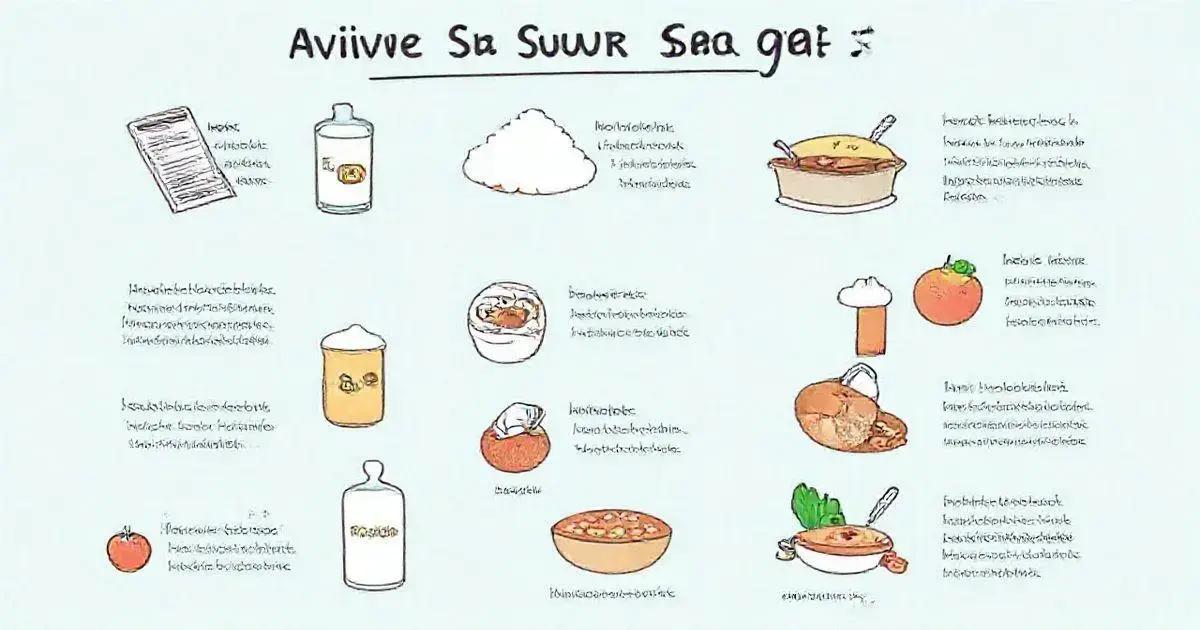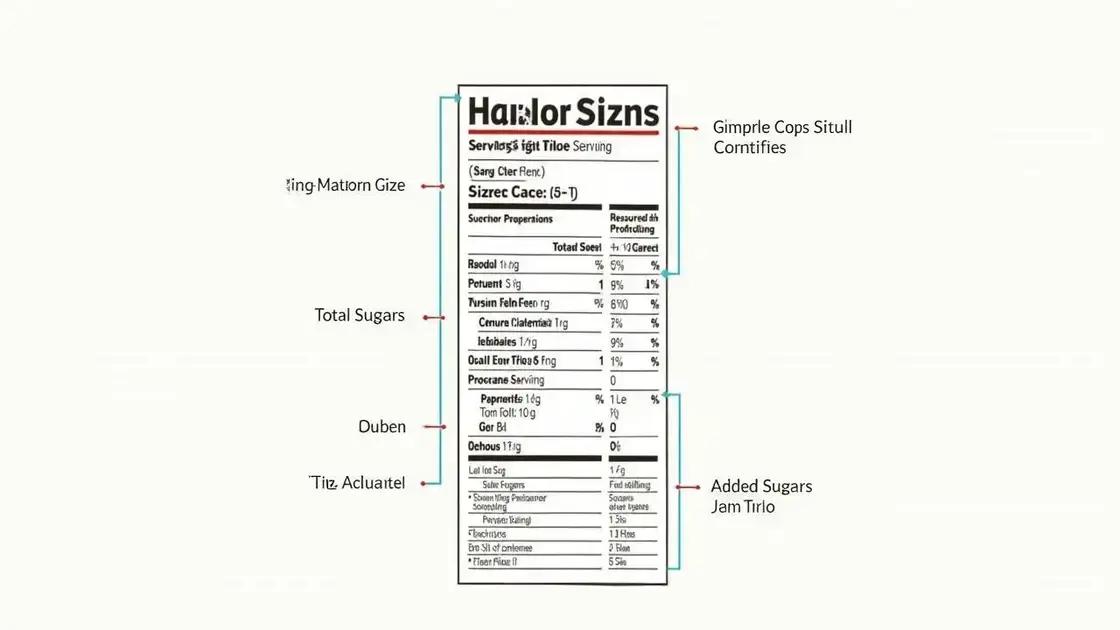To identify and avoid sneaky sources of sugar, read food labels carefully for total and added sugars, recognize common foods that hide sugar, and adopt practical tips like choosing whole foods, limiting sugary drinks, and cooking at home to maintain a healthier diet.
Identifying and avoiding sneaky sources of sugar is essential for maintaining a healthy diet. Many foods that seem healthy are often loaded with hidden sugars, making it challenging to control your intake. In this article, we will explore the nature of hidden sugars, highlight common foods that may be misleading, and provide practical tips to help you steer clear of excess sugar in your meals.
Understanding Hidden Sugars

Understanding hidden sugars is vital for making healthier choices in your diet. Sugar can be found in many foods, even those labeled as “healthy”. It is important to look beyond the obvious sources of sugar, such as candies and desserts. You may be surprised to discover where sugar is hiding.
What Are Hidden Sugars?
Hidden sugars are sugars that are not immediately apparent when reading food labels. They can come from various ingredients, including high fructose corn syrup, sucrose, honey, and even certain fruit juices. Many brands use these sugars as sweeteners in products that are supposed to be nutritious.
Why Are They Problematic?
Consuming too much sugar, especially from hidden sources, can lead to health issues like obesity, diabetes, and heart disease. Hidden sugars can cause spikes in your blood sugar levels, contributing to energy crashes and increased cravings. Being aware of these sugars can help you maintain steady energy levels and overall well-being.
Identifying Hidden Sugars
To effectively identify hidden sugars, examine the ingredient list on food packaging. Look for any of the many names sugar can go by, including glucose, fructose, and dextrose. If sugar is one of the first few ingredients listed, the product likely contains a significant amount of sugar.
Healthy Alternatives
Instead of products with hidden sugars, consider choosing whole foods like fruits, vegetables, and whole grains. These foods not only provide vitamins and minerals but also have natural sugars that are less likely to spike your blood sugar. Incorporating these alternatives into your diet can help reduce your overall sugar intake.
Common Foods That Hide Sugar

Many everyday foods contain surprising amounts of sugar. Recognizing these foods is important for managing your sugar intake. Here are some common culprits that often hide added sugars:
1. Yogurt
Many flavored yogurts, even those labeled as “low-fat,” can be high in sugar. Always check the sugar content on the label. Opt for plain yogurt and add fresh fruit for natural sweetness.
2. Sauces and Condiments
Condiments like ketchup, salad dressings, and BBQ sauce can pack in sugar. For example, ketchup contains multiple sugars, making it much sweeter than you’d expect. Consider making homemade sauces to control the ingredients.
3. Granola Bars
Granola bars are often marketed as health foods, but many brands add significant sugar to enhance flavor. Look for options that contain whole grains and minimal added sugars or prepare your own at home.
4. Breads and Baked Goods
Some breads, especially those labeled as “whole grain,” can contain added sugars. Check the ingredient list to see if sugar is included, and consider whole foods like oatmeal or homemade bread.
5. Breakfast Cereals
Many breakfast cereals, even those that appear healthy, are often loaded with sugar. Look for cereals with whole grains and little to no added sugars, or consider oatmeal for a better option.
6. Dried Fruits
Dried fruits are another source of hidden sugar. They can be concentrated with sugar during the drying process. Always choose unsweetened varieties to avoid extra sugar intake.
Tips for Avoiding Sugar

Avoiding sugar can be challenging, but with the right strategies, you can reduce your intake. Here are some practical tips to help you steer clear of sneaky sugars:
1. Read Labels Carefully
Always check nutrition labels for sugar content. Look for both total sugars and added sugars. If sugar is one of the first ingredients, consider choosing a different product.
2. Choose Whole Foods
Opt for whole, unprocessed foods as much as possible. Fresh fruits, vegetables, nuts, and whole grains are less likely to contain hidden sugars. These foods also provide essential nutrients and fiber.
3. Limit Sugary Drinks
Many beverages like sodas, fruit juices, and sweetened coffee drinks can significantly contribute to sugar intake. Choose water, herbal teas, or black coffee instead.
4. Cook at Home
Preparing meals at home allows you to control the ingredients. You can use fresh herbs and spices to flavor your dishes instead of relying on sauces and condiments that may contain hidden sugars.
5. Find Healthy Substitutes
If you crave sweetness, consider natural alternatives like stevia or monk fruit instead of regular sugar. These options can provide sweetness without the extra calories.
6. Balance Your Meals
Including protein and healthy fats in your meals can help stabilize your blood sugar levels and reduce cravings for sugar. Try to combine carbohydrates with proteins or fats to keep you full longer.
Reading Labels: A Key to Success

Reading labels is a crucial skill for anyone looking to reduce sugar intake. Understanding what to look for on food labels can help you identify hidden sugars and make healthier choices. Here are key points to keep in mind:
1. Check the Serving Size
The serving size is the first thing to look at. Many products have a small serving size that can make the sugar content seem lower. Always consider how many servings you consume.
2. Look for Total Sugars
Total sugars include both natural and added sugars. Be cautious of products that have high total sugars. Aim for foods with lower total sugar content when possible.
3. Identify Added Sugars
Added sugars are sugars that manufacturers include during processing. Look for the “added sugars” section to see how much extra sugar is included. This can shed light on how much sugar you are consuming unnecessarily.
4. Know the Different Names for Sugar
Sugar can be listed under many names, including corn syrup, honey, sucrose, and fructose. Familiarizing yourself with these names can help you spot hidden sugars more easily.
5. Be Cautious with Healthy Labels
Foods marketed as “healthy” can still contain significant sugar. Just because a product claims to be low-fat or all-natural doesn’t mean it’s low in sugar. Always read the label to be sure.
6. Use a Nutrition App
Using a nutrition app can simplify tracking sugar intake. Many apps scan barcodes and provide immediate information on sugar content, making it easier to choose better options.
Managing Your Sugar Intake for a Healthier Lifestyle
Understanding how to identify and avoid sneaky sources of sugar is a key component of maintaining a healthy diet. By recognizing hidden sugars in common foods, reading labels carefully, and implementing practical tips, you can take control of your sugar consumption.
Remember that the journey to reducing sugar intake is personal and may take time. Focus on making gradual changes that fit your lifestyle, such as choosing whole foods and preparing meals at home. These steps can lead to better energy levels, improved health, and overall well-being.
With awareness and education, you can successfully navigate the world of sugar and make informed choices that benefit your health.
FAQ – Frequently Asked Questions about Reducing Sugar Intake
Why is it important to reduce sugar in my diet?
Reducing sugar can help prevent health issues such as obesity, diabetes, and heart disease while improving overall energy levels and wellness.
How can I identify hidden sugars in foods?
You can identify hidden sugars by reading food labels, checking for total and added sugars, and familiarizing yourself with different names for sugar.
What are some common foods that contain hidden sugar?
Common foods with hidden sugars include flavored yogurts, sauces, granola bars, breads, and some breakfast cereals.
What tips can I use to avoid sugar?
Tips include reading labels carefully, choosing whole foods, limiting sugary drinks, and cooking at home to control ingredients.
How do I read food labels effectively?
Focus on serving sizes, look for total sugars and added sugars, know the names for sugar, and be cautious of foods with health claims.
Are there healthy alternatives to sugar?
Yes, consider using natural sweeteners like stevia or monk fruit as alternatives to regular sugar, and choose whole foods for natural sweetness.












